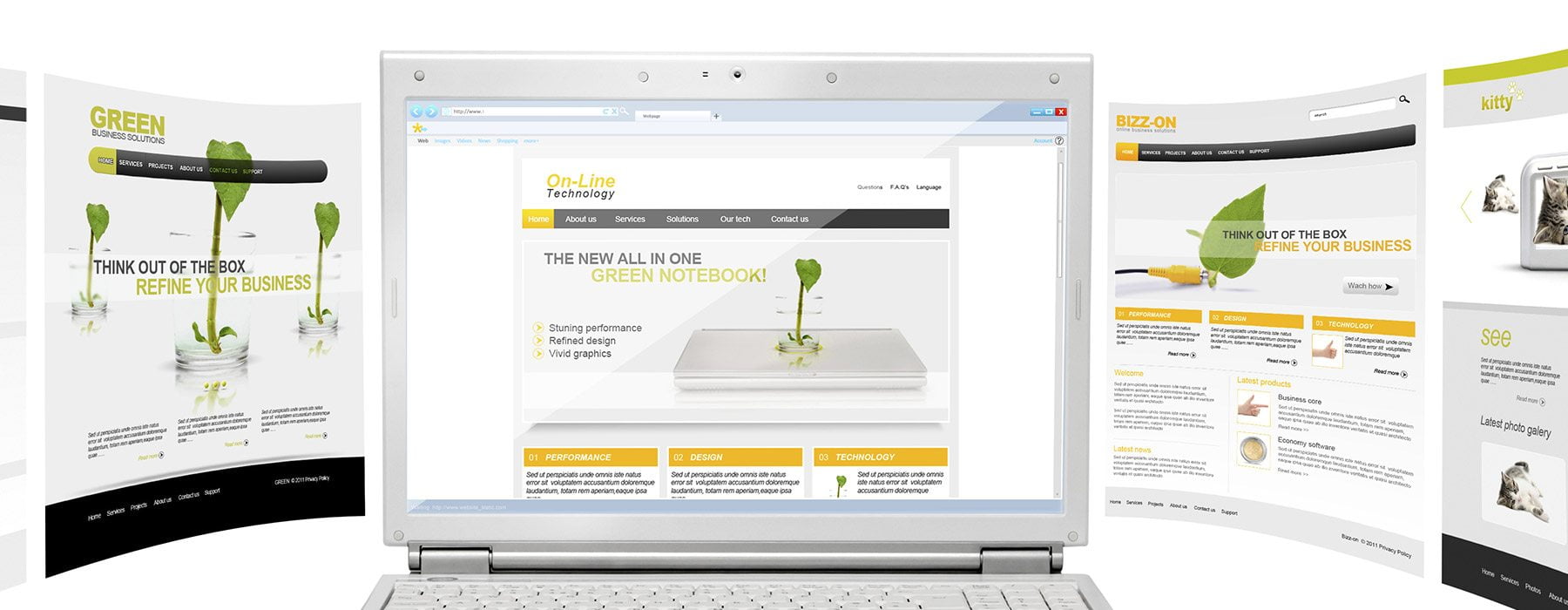“It is often our unconscious mind that determines action… subjectively based on how we perceive appeal, content, familiarity, trustworthiness, likeability, and need.”
What is a Landing Page?
A landing page represents a standalone web page that is separate from your main website. The purpose of the landing page is to bring the viewer to a focused page that will limit their options and further lead them through to your planned conversion goal. It is your ultimate inbound lead conversion tool.
There are two types of landing pages. The first is a click through landing page, designed to encourage the viewer to click through to another page. These are used most frequently in ecommerce funnels. They typically feature a call to action (CTA) in order for the user to move on to the next step in the sales process.
The second is a inbound lead generation page, designed to capture viewer data. This page is dedicated to obtaining information about users that can later be used for marketing. Many lead generation pages feature discount coupons/vouchers, eBooks, and other free offers in exchange for information, contest entry, or free trials. Data is most commonly captured through use of a contact form the visitor must fill out and submit.
Why are Landing Pages Important?

Believe it or not, landing pages play a huge role in a website’s success. The reason behind this really stems from the human brain. While our conscious mind may not be recognizing specific elements about a webpage, our unconscious mind takes in the details. It is our unconscious mind that determines whether we click through or not; based on how we perceive the design, content, familiarity, trustworthiness, likeability, and a very large number of other factors, all influencing our feelings about the page. That being said, the landing page is an essential tool in ensuring that you achieve inbound lead conversions through your website.
What is the Psychology of Landing Pages?
A viewer’s decision making follows four basic steps.

Step 1: Acknowledging the Problem
First, the viewer must establish that they have a problem, a pain, or an unmet need. At this point, the viewer is experiencing an emotional dilemma and is looking for a solution. Skilled marketers use these emotions and develop a landing page to appeal directly to this need. Often, during this stage, the viewer doesn’t even know what they’re looking for or why, and so the landing page is especially important as it can be very impactful and influential on their final choices.
Step 2: Searching for a Remedy
Next, a viewer must find a solution to fix or solve their problem or need. Viewers often reach out to search engines to obtain answers, as this is an efficient way to obtain a significant amount of information about any give problem or need. In this stage, a viewer is seeking a trusted product/service to meet their needs.
A landing page should be sure to convey trust and security. Keep in mind that a landing page is often the first impression of your site, product, and business. First impressions, as you well know, are very impactful in every setting; social, business and virtual.
If your landing page leaves a bad first impression, viewers will not continue viewing and will certainly not make a purchase or provide you with a lead. You get one shot to make a first impression, your landing page has to be awesome. You also must make sure you are providing the right solution to the right audience. It’s not uncommon for business owners to think they know their audience when truly they could be way off the mark.
Step 3: Weighing All Options
The third step in the viewer’s decision-making process is weighing out their options. During this step, the viewer knows they have a problem they need to solve and are looking for a way to do so. Now, they need to decide what solution would be best. While decisions are usually related to price, quality, and efficiency we cannot minimize the importance of the landing page in this situation.
The landing page must appeal to their desires:
- what does the viewer want?
- Is price their motivating factor?
- Quality?
- Results from the purchase? Etc.
Step 4: Buy Now or Move On
The final step in this process the viewer will make a selection… or not. At this point, the viewer has compiled all of the information from their search for a solution as well as put to use the subconscious information the brain has absorbed through the evaluation process. Because a landing page is so critical in a viewer’s decision to buy or leave, it is critical that the page holds no distractions. We want to viewer to move forward with the selection. Too much information on the landing page will make the decision more difficult. Simplicity is key to a great landing page. It should have a singular focus and be set up to drive the viewer to take one particular action.
How to Use the Psychology of Landing Pages to Your Advantage

So, the process seems simple enough and understanding the psychology of landing pages that plays into a viewer’s selection process seems straight forward. So…what can you do with this information and how can you use it to develop a great landing page? Take a look at the following essential elements to a psychologically appealing landing page.
An Awesome Call to Action:
The Call to Action (CTA) represents the main reason the viewer is on the page. Given this, the CTA should be the only clickable item on the page to ensure you direct the viewer’s path to your intended goal. Think of a one track mind. Too many links on a landing page gives the viewer too many opportunities to say no and change their mind. The most successful landing pages refrain from including other links outside of the CTA.
Direct Product Description and Price
Given that the entire human population struggles with attention issues (and it’s getting worse) – it is important to provide a quick, direct description that demands the attention of the viewer. Lengthy content with the expectation your viewers will have the time or patience to read until their eyeballs bleed will get you nowhere fast. Viewers get bored and with a landing page especially, they found the page because they need a solution to a problem. They know what the problem is and do not need a long-winded explanation, just the solution. Keep your description short and to the point so that your viewers know what they are clicking for.
Desire
You want your viewers to want your product/service. How do you get them to want it?
Present the material in the most desirable way that makes sense for your target audience. Figure out what your viewers want and present your copy, visuals, and offers in such a way that they simply can’t resist.
Testimonials
Remember the decision making stage where your viewer is trying to build trust (step 2 above)? Testimonials do just that. By using actual customer feedback on your landing page you provide your viewer with all the more reason to move forward with the transaction because they want to experience the same feeling and/or result that the satisfied customer went through. Testimonials serve as anecdotal evidence proving your worthiness, authority, expertise, and willingness to go the extra mile to satisfy your customers. Often, customer testimony is one of the most powerful motivators to compel someone to go through with the investment in your business.
Urgency
A sense of urgency on your landing page will encourage a quicker decision by your viewer. Urgency activates a specific part of the brain that plays a big role in decision making. It motivates the viewer to decide quickly. “Limited time offers” serve as great advertising to create a sense of urgency. Find ways to offer discounts or other compelling price motivators that will make visitors feel compelled to act now.
Inbound Lead Conversion Mistakes to Avoid

As with all marketing, you run the risk of having an unsuccessful landing page. Fortunately, a lot of people have experienced landing page mistakes, and have published them to keep you from making the same errors. Take a look at the following mistakes to avoid.
Lacking a Clear Conversion Goal
You must know your goal to measure your success. What is the conversion goal of your landing page? Once you determine this, you develop your landing page to support it. Always know the intended purposes of the page first! Your page will fail miserably if you don’t. The best way to avoid this mistake – don’t beef up your landing page until you have a clear conversion plan in place. Start simple and build up the page over time.
Creating your Landing Page Based on Your Preferences
Your viewers don’t care what your favorite color is or how awesome your copy sounds. Your landing page needs to be reflective of what your viewers what to see, not what you think looks cool. Identify an idea of what your viewers would want to see, and stick with it. This is the case for all web pages of any website. While many business owners can’t see past their own egos, a website is not about your needs, but your customers so always put them first.
Thinking that all Landing Pages are the Same
Every landing page should be different, as the goal of every landing page is different. There is no “one size fits all” formula for developing a landing page. They all hold different elements and support different goals. You will need to test what pages work best for your viewer population. Learn from your mistakes and never assume that you’ve got the ultimate landing page for every site- it just doesn’t work that way.
Wrap Up
Landing pages can be a key element in the success of your online marketing endeavors. The best landing pages have been developed to really consider the thought process of the viewer. Decision making holds a significant psychological element that cannot be ignored when developing your landing page and must be taken into consideration to generate quality inbound lead conversions for your website.
- First identify the goal of your landing page.
- Once you have done that you can begin to evaluate your viewers and identify what landing page design will best meet their needs.
- Remember, there is no right way to develop a landing page and all of them are different.
- Consider the psychology of landing pages as well as behind the decision making process and do your best to develop an awesome page that will support your conversion goal.
- And, make sure to track progress and apply the lessons learned to the rest of your marketing as landing pages can give you mountains of information about the behaviors of your potential customers.
Creating landing pages that generate quality inbound lead conversions into sales can often require a bit of expertise in both understanding your target audience as well as creating an appealing page, well-written content, and a worthwhile offer that entices the visitor to take the next step. We can help discuss your inbound marketing strategy and help develop better-converting landing pages and goals for your business. Reach out to us anytime to learn more.












